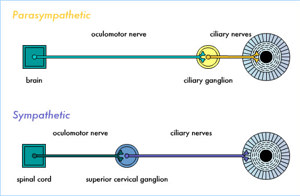Autonomic Pharmacology
By David Dewhurst, Michael Lew, James Ziogas & Stewart Cromar
| Record number: | 54d77 (legacy id: 5439) |
|---|---|
| Category: | Pharmacology |
| Type: | Computer Program |

Description: Autonomic Pharmacology is a computer simulation of the effects of drugs on the human eye to teach autonomic pharmacology.
This highly interactive program is based on a number of virtual patients with medical conditions which result in abnormal pupillary reflexes. It is designed to allow students to investigate the effects on the pupil diameter of the human eye of a physiological stimulus (change in light intensity) and a number of pharmacological agents which should help to suggest the underlying cause of the condition. The normal response to a change in light intensity is controlled by the autonomic nervous system and the program therefore provides a useful model for investigating autonomic pharmacology. Some of the agents could be administered externally to the real eye but others would not be safe.
The 'Tutorial' section describes, using text and animated schematic graphics, the sympathetic and parasympathetic control of pupil diameter and how pupil diameter changes in response to a change in ambient light intensity.
The 'Student Exercise' section provides information on how to work through the investigation on a virtual patient using a 'normal' patient as an illustration. Thus students have the opportunity to investigate how the normal pupil will respond to a change in ambient light intensity, investigate the blink reflex and text the action of a number of pharmacological agents. They are encouraged to measure the pupil diameter (using an on-screen cross-hair cursor) at a range of light intensities and to observe, for each eye, the speed with which the pupil diameter changes. They can also investigate the action of a number of pharmacological agents applied topically to the eye (single dose, enough for a large, but not maximal, response in eyes that are responsive) and record their observations on an on-screen chart. The agents available (atropine, pilocarpine, physostigmine, phenylephrine, cocaine, and amphetamine) all affect neurotransmission at the postganglionic sympathetic and parasympathetic synapses and have little effect on ganglionic transmission. There is also a 'washout' facility which instantly removes the applied drugs whereas in the real situation several hours might be required for some of the drug effects to be reversed.
The 'Simulation' section contains four virtual patients each suffering from a medical condition which results in an abnormal pupillary reflex in one eye:
- normal but with reddening of the eye and physiological anischoria;
- Horner's syndrome (pre-ganglionic);
- Horner's syndrome (postganglionic);
- partial parasympathectomy.
Students first take measurements of the response to a change in light intensity which should give a clue to the underlying problem. They can then investigate this further by choosing two of the drugs from the list and observing their effects - that is sufficient to test the best hypothesis for each patient. To confirm their diagnosis students can then choose to administer one more agent after which they will be expected to select a diagnosis from the list.
Please click here for more information.
Language: English
Recommended System Requirements:
Safari 5.0 or later, Mozilla Firefox 4.0 or later, Google Chrome or Edge
Target Audience:
Particularly suitable for undergraduate students from a range of biological science, medical and health-related courses.
Price: £250 (multiuser, educational licence)
Thanks for your feedback! Please note that we cannot reply to you unless you send us an email.
What are you looking for?
We value your feedback so we can improve the information on the page. Please add your email address if you would like a reply. Thank you in advance for your help.!
Please contact us by email if you have any questions.
